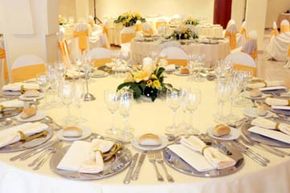Can't tell a demitasse spoon from a dinner napkin? You're not alone.
Table settings weren't always so exacting. In the days of damsels and dungeons, only the most civilized diners used a knife to spear their food. The rest ate with their fingers.
Advertisement
Of course, this made it easy to set a table. But it didn't last. Mealtime etiquette grew increasingly elaborate. During the Victorian era, navigating a formal dinner required skill. Each place setting included dozens of strategically laid pieces, each with a singular purpose.
Although we've been liberated from wearing powdered wigs or corsets to dinner, table settings are still a necessary art. Pairing the right fork with the proper course is more than a fancy nicety -- it will make you feel more comfortable in persnickety social situations, like dining in a five-star restaurant with your new boss.
Fortunately, remembering which tableware to use is as simple as forming a circle with your thumb and forefinger while holding the rest of your fingers straight up. Your left hand will form a "b," indicating that your bread plate is on the left side of your main plate. The "d" made by your right hand signals that your drink is to the right.
Wondering which fork to use? Simply work from the outside to the inside. Use the outermost utensils for your first course; use those nearer your plate with each successive dish.
The type of place setting used for each meal becomes more complex as the day progresses. Even the fanciest breakfast setting is a relatively simple affair; it includes a cereal bowl placed in the center of a full-size plate, a single fork and napkin to the left, a bread-and-butter plate and knife above that, a single knife and teaspoon to the right of the main plate, glasses for water and juice above that and, finally, a cup, saucer and demitasse spoon (which is smaller than a teaspoon) for coffee or tea to the right of the knife and teaspoon.
A lunch setting is similar, but the bowl will be used for soup rather than cereal, a wine glass will replace the juice glass and coffee or tea may not be served. A family-style dinner setting is equally pared down, but with no soup bowl, the napkin initially placed on top of the main plate and a salad plate to the left of the fork.
A place setting for a formal evening meal includes three forks (salad, dinner, dessert), two spoons (teaspoon, soupspoon), two knives (dinner, butter), three plates (salad, dinner, bread) and three glasses (water, red wine, white wine). Additional glasses may appear if each course includes its own wine pairing. You also may have a dessert spoon and fork above your main plate.
Regardless of the settings used, the most important technique that you bring to the table will be your ability to overlook the etiquette breaches of fellow diners. To forgive a misstep is good manners, too.
Advertisement
